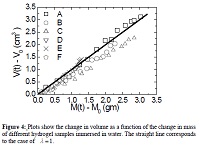An experimental study of the swelling properties of spherical hydro-gel immersed in water and the formulation of a simple theoretical model for its explanation.
Keywords:
super-absorbent polymer, hydro-gel swelling, diffusion, porous hydro-gel, mass swelling ratio, volume swelling ratio, equilibrium water content, equilibrium swelling ratioAbstract
The mechanism of variation of mass and volume, through the absorption of water, by the most commonly used and abundantly available spherical hydro-gel beads of various colours has been studied. Immersing the beads in distilled water, both mass and volume were measured at regular intervals. By an analysis of mass-versus-time data, using standard theoretical methods, the mechanism of diffusion of water has been studied. Relaxation controlled transport was found to be the predominant process of diffusion of water into the materials under study. The diffusion coefficient has been determined for hydro-gels of different colors. Various swelling related parameters such as equilibrium water content, equilibrium swelling ratio, characteristic time, initial rate of water absorption etc. were determined for these hydro-gels. The maximum attainable mass and the maximum number of water molecules that can be attached to active polymer sites in a single bead have been calculated. In this regard, the number of such active sites per unit volume and mass of dry hydro-gel was determined. A theoretical model has been developed, based on the consideration of water absorption through the occupation of vacant polymer sites in a highly porous hydro-gel. Considerations of cylindrical and spherical pores in this model predicted almost the same swelling behavior. Expressions relating mass and volume with time have been formulated and they agreed well with experimental observations. The dependence of characteristic time (τ ) upon structural parameters have been established. Values of swelling related parameters have been determined by a numerical fitting of theoretical model to experimental data. The agreement of experimental findings with theoretical predictions has been depicted graphically.
References
Barati A, Norouzi H, Sharafoddinzadeh S, Davarnejad R, Swelling Kinetics Modeling of Cationic Methacrylamide-Based Hydrogels, World Applied Sciences Journal, vol. 11 (11), p. 1336-1341, 2010
Pal K, Banthia AK, Majumdar DK, Polymeric Hydrogels: Characterization and Biomedical Applications –A mini review, Designed Monomers and Polymers, vol. 12, p. 197, 2009.
Chatterjee AN, Yu Q, Moore JS, Aluru NR, Mathematical Modeling and Simulation of Dissolvable Hydrogels, Journal of Aerospace Engineering, April 2003 issue, p. 55, 2003.
Porter TL, Stewart R, Reed J, Morton K, Models of Hydrogel Swelling with Applications to Hydration Sensing, Sensors, vol. 7, p. 1980, 2007.
Kost J, Pulsed and self-regulated drug delivery, 1990, CRC, Boca Raton, Fla.
Cohen YB, Electro active polymers as artificial muscles-reality and challenges, Proc. of the 42nd AIAA Structures, Structural Dynamics, and Materials Conference (SDM), Pasadena, Calif., 2001.
Thakur A, Wanchoo RK, Singh P, Structural Parameters and Swelling Behavior of pHSensitive Poly(acrylamide-co-acrylic acid)Hydro-gels, Chem. Biochem. Eng. Q., vol. 25 (2), p. 181, 2011.
Saraydin D, Karadag E, Cetinkaya S, Guven O, Radiat. Phys. Chem., vol. 46, p. 1049, 1995.
Peppas NA, Bures P, Leobandung W, Ichikawa H, Eur. J. Pharma. Biopharm., vol. 50, p. 27, 2000.
Brannon-Peppas L, Medical Plastics and Biomaterials Magazine, November 1997, Medical Device Link, 1997.
Hoffman AS, Adv. Drug. Del. Rev., vol. 54, p. 03, 2002.
Saraydin D, Karadag E, Guven O, Sep. Sci. Technol., vol. 30, p. 3291, 1995.
Makuuchi K, Critical Review of Radiation Processing of Hydro-gel and Polysaccharide, Radiat. Phys. Chem., vol. 79(3), p. 267, 2010.
Xinming L, Yingde C, Lloyd AW, Mikhalovsky SV, Sandeman SR, Howel CA, Liewen L, Contact Lens-Based Ophthalmic Drug Delivery Systems: A Review. Contact Lens and Anterior Eye, vol. 31(2), p. 57, 2008.
Chang C, Duan B, Cai J, Zhang L, Superabsorbent Hydro-gels Based on Cellulose for Smart Swelling and Controllable Delivery, Eur. Polym. J., vol. 46(1), p. 92, 2010.
Hoffman AS, Hydro-gels for biomedical applications, Advanced Drug Delivery Reviews, vol. 54: p. 3, 2002.
Ganji F, Vasheghani-Farahani S, Vasheghani-Farahani E, Theoretical Description of Hydro-gel Swelling: A Review, Iranian Polymer Journal, vol. 19 (5), p. 375, 2010.
Siepmann J, Peppas NA, Modeling of drug release from delivery systems based on hydroxypropyl methylcellulose (HPMC), Adv. Drug Deliv. Rev., vol. 48, p. 139, 2001.
Bartil T, Bounekhel M, Cedric C, Jerome R, Swelling behavior and release properties of
pH-sensitive hydro-gels based on methacrylic derivatives, Acta Pharm., vol. 57, p. 301, 2007.
Berens AR, Hopfenberg HB, Diffusion and relaxation in glassy polymer powders: Separation of diffusion and relaxation parameters, Polymer, vol. 19, p. 489-496, 1978.
Naghash HJ, Okay O, J. Appl. Polym. Sci., vol. 60, p. 971, 1996.
Quintana J R, Valderruten NE, Katime I, Langmuir, vol. 15, p. 4728, 1999.
Peppas NA, Sahlin JJ, A simple equation for the description of solute release: Coupling of diffusion and relaxation, Int. J. Pharm., vol. 57, p. 169, 1989.
Caykara T, Kiper S, Demirel G, Thermosensitive poly (N-isopropylacrylamide-co-acrylamide) hydro-gels: Synthesis, swelling and interaction with ionic surfactants, European Polymer Journal, vol. 42, p. 348, 2006.
Korsmeyer RW, Peppas NA, in Controlled release delivery systems, New York: Marcel Dekker, 1983.
Horie K, Báron M, Fox RB, He J, Hess M, Kahovec J, Kitayama T, Kubisa P, Maréchal E, Mormann W, Stepto RFT, Tabak D, Vohlídal J, Wilks ES, Work WJ, Definitions of terms relating to reactions of polymers and to functional polymeric materials (IUPAC Recommendations 2003), Pure and Applied Chemistry, vol. 76 (4), p. 889, 2004.
Buchholz FL, Graham AT, ed. Modern Superabsorbent Polymer Technology (1 ed.), John Wiley & Sons, ISBN 0471194115, 1997.
Dinu M, Perju MM, Cazacu M, Dragan ES, Polyacrylamide-dextran Polymeric Networks: Effect of Gel Preparation Temperature on Their Morphology and Swelling Properties, Cellulose Chem. Technol., vol. 45 (3-4), p. 197, 2011.
Gemeinhart RA, Park H, Park K, Pore Structures of Super-porous Hydro-gels, Polymers for Advanced Technologies, vol. 11, p. 617, 2000.





